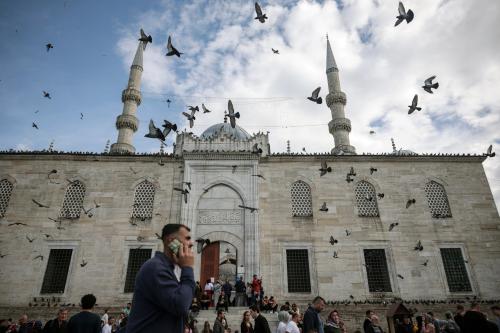Swaziland rarely tips the balance in international politics. But one month ago, Swaziland made history by becoming the fifteenth state to ratify the world’s newest treaty, the African Union Convention on the Protection and Assistance of Internally Displaced Persons in Africa. Known as the Kampala Convention, it is the world’s first binding agreement on internally displaced persons, or IDPs. With Swaziland’s ratification, the Convention comes into force on December 6, and it’s not a minute too soon.
IDPs are individuals who have had to flee their homes, but unlike refugees they have not crossed an international border. Consequently, many IDPs struggle to access essential humanitarian assistance and protection of their rights. Around the world, more than 26 million people are internally displaced due to conflicts. More than a third of them are in Africa. In fact, some of the world’s most complex internal displacement crises are to be found in Africa, from the uprootings in northern Mali to the protracted displacement situation in Darfur and the emergency in the Democratic Republic of Congo (DRC), where thousands fled after the M23 rebel group captured the eastern city of Goma last month. In addition to the almost 9 million African IDPs uprooted by conflicts, thousands if not millions more have been displaced by development projects, land grabbing and environmental disasters, many linked to the effects of climate change.
In this landscape of struggle, the Kampala Convention stands out as a remarkable achievement that may – if taken seriously – make a concrete contribution to improving the lot of IDPs in Africa.
The Kampala Convention is not the first time African states have taken the lead in developing new laws to protect and assist those forced to flee their homes. In 1969, the Organization of African Unity developed a new international convention that dramatically expanded refugee protection in Africa, taking into account the particular challenges proxy wars and independence struggles posed for refugees across the continent. The Kampala Convention follows in this tradition, addressing increasingly significant causes of displacement such as natural disasters, and important new actors in displacement contexts, such as multinational corporations and private security forces. The Convention strengthens the prohibition on arbitrary displacement, and the right to a remedy for those affected by displacement. It addresses the rights and needs of those who are internally displaced, but also directs states to take action to prevent displacement, and to promote its resolution.
Bringing together the Kampala Convention has been an enormous accomplishment, but this is not the end of the process. The challenge now is to transform these provisions into tangible improvements in the rights and wellbeing of IDPs across Africa. What would it take to make this happen?
First, concerted efforts are needed to encourage those African countries that have not yet signed or ratified the Convention to do so as soon as possible. Several states with serious displacement crises such as the DRC, Somalia, Sudan, South Sudan and Côte d’Ivoire have not yet ratified the agreement, but IDPs in these countries would undoubtedly benefit from Convention’s protections.
Second, awareness-raising initiatives are required so that government and civil society actors at different levels across the continent can learn about the Convention and its implications for their work. Parallel efforts are needed amongst international organizations and donor officials that may be in a position to help promote and support the implementation of the Kampala Convention. Information about the Convention should also be shared with other regional organizations and governments outside of Africa, who may be interested in applying the insights from the Kampala Convention process to their own contexts.
Third, the Kampala Convention’s international supporters should help facilitate the development of an African-led implementation plan for the Convention. This would build on the activities that have already started to promote the agreement’s implementation, such as the development of the AU Model Law on the Kampala Convention. It would likely entail activities on several fronts, including trainings and support for the development of comprehensive national laws and policies on internal displacement that anchor states’ obligations under the Convention in robust domestic frameworks. These domestic laws and policies must ensure that adequate support is provided from national budgets to implement the Convention (as the Convention indeed requires), and that the specific national authorities responsible for upholding the Convention are clearly identified. Experiences in Africa and around the world have demonstrated that backing up innovative international agreements such as the Kampala Convention with strong domestic laws is essential to ensuring that the obligations laid out in these instruments don’t just exist on paper, but translate into improved practice. This lesson needs to guide efforts to implement this new Convention on IDPs.
As one of the principal drafters of the Kampala Convention, the Special Rapporteur on the Human Rights of Internally Displaced Persons, Dr. Chaloka Beyani, is uniquely positioned to play an important leadership role, alongside African states and the AU, in the development and execution of such a plan. Timely support from UN agencies, donors and other international actors will be critical to backstopping the leadership shown on this issue by the AU and its member states. Five years from now, the Kampala Convention will, according to the terms of the agreement, come up for review. Our challenge is to ensure that 2017 is time for the celebration of another landmark for human rights: the comprehensive implementation of the Kampala Convention across the African continent.
The Brookings Institution is committed to quality, independence, and impact.
We are supported by a diverse array of funders. In line with our values and policies, each Brookings publication represents the sole views of its author(s).



Commentary
A Landmark for Human Rights: The Kampala Convention on Internal Displacement Comes into Effect
December 6, 2012